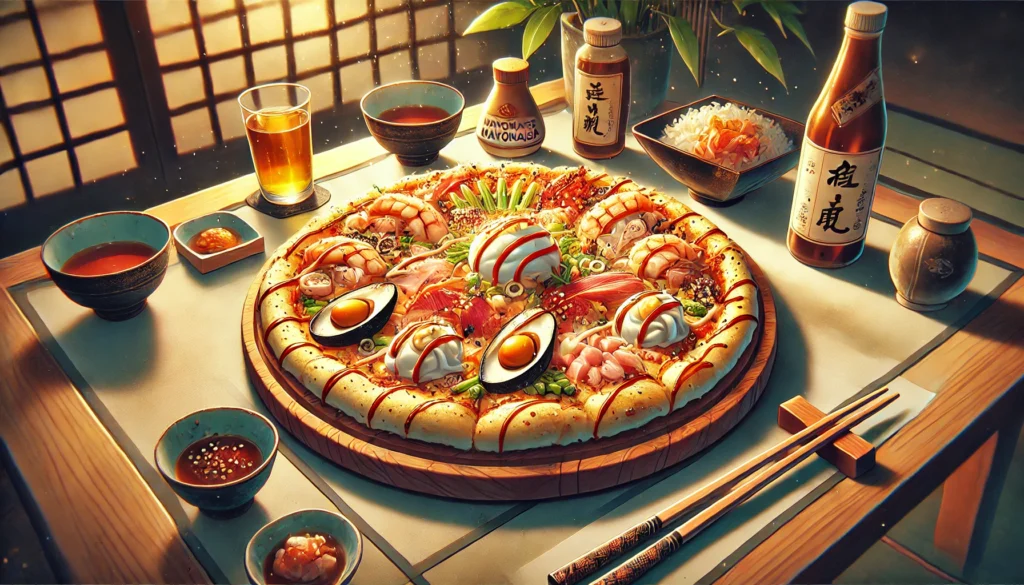Curious about how Pizza Hut has adapted to Japanese tastes? This comprehensive Pizza Hut in Japan review explores the unique menu offerings, pricing, cultural adaptations, and how it compares to other Japanese pizza chains—all without stepping foot inside!
Introduction: The Fascinating World of Japanese Pizza
When most people think of Japanese cuisine, images of sushi, ramen, and tempura typically come to mind. However, Japan has embraced and transformed Western food concepts in fascinating ways, and pizza is no exception. As an enthusiast of Japanese culture and cuisine, I’ve researched extensively into how international food chains adapt to local palates, with Pizza Hut in Japan being a particularly interesting case study.
While I haven’t personally visited Pizza Hut in Japan (transparency is important!), I’ve gathered insights from Japanese residents, food bloggers, and official menu information to create this comprehensive Pizza Hut in Japan review. This exploration reveals how a familiar American brand transforms when filtered through Japanese culinary sensibilities.
The History of Pizza Hut in Japan
Pizza Hut first entered the Japanese market in the 1970s, joining the wave of American fast-food chains expanding into Asia. Unlike some foreign concepts that struggled to gain acceptance, pizza found a receptive audience in Japan, though not without significant adaptation to local tastes.
The chain has evolved over decades to create a unique identity that differs substantially from its American counterpart. This evolution mirrors Japan’s broader relationship with imported cuisine—embracing the concept while transforming it into something distinctly Japanese.
Menu Deep Dive: Uniquely Japanese Pizza Offerings
Unexpected Toppings That Surprise Western Visitors
One of the most striking aspects of any Pizza Hut in Japan review is the discussion of toppings that might seem unusual to Western palates. Where American Pizza Hut locations focus on pepperoni, cheese, and meat-lover combinations, Japanese menus feature:
- Seafood Deluxe: Topped with shrimp, squid, tuna, and sometimes crab
- Teriyaki Chicken: Featuring sweet teriyaki sauce instead of traditional tomato
- Mayonnaise Corn Pizzas: A surprisingly popular combination that reflects Japanese flavor preferences
- Mentaiko (Spicy Cod Roe) Pizza: A uniquely Japanese offering that showcases local seafood traditions
These toppings reflect Japanese culinary preferences, particularly the emphasis on seafood and the enjoyment of mayonnaise as a flavor enhancer rather than just a condiment.
Specialty Crusts Beyond the American Imagination
While Pizza Hut is known for crust innovations worldwide, the Japanese versions take creativity to new levels:
- Rice Crust Options: Catering to local grain preferences
- Stuffed Crusts with Unique Fillings: Including options like sweet potato, cheese with honey, or even shrimp
- Mini Hot Dogs Embedded in Crust: Creating a two-in-one meal experience
- Ultra-Thin “Japanese Style” Crusts: Appealing to local preferences for lighter options
These adaptations show how Pizza Hut has worked to blend American concepts with Japanese preferences, creating hybrid food experiences that wouldn’t be recognized by American customers.
Price Comparison: Why Pizza is a Luxury Food in Japan
A significant aspect of any Pizza Hut in Japan review must address the pricing structure, which often shocks Western visitors. While pizza is considered an affordable fast food in America, in Japan it occupies a more premium position:
- Average Cost: A medium specialty pizza typically costs between ¥2,500-¥3,500 (approximately $23-$32)
- Premium Options: Special seasonal offerings can reach ¥4,000 (around $37) for a medium pizza
- Comparison: This makes Japanese pizza 2-3 times more expensive than equivalent American options
This price differential stems from several factors:
- Imported ingredients commanding premium prices
- Higher operational costs in Japanese urban centers
- Positioning as a special occasion food rather than casual dining
- Cultural perception of foreign foods as premium experiences
The luxury positioning of pizza in Japan explains why many chains focus on theatrical presentation, premium ingredients, and elaborate flavor combinations that wouldn’t be cost-effective in American markets.
The Dining Experience: Atmosphere and Service Differences
Restaurant Aesthetics
Pizza Hut locations in Japan differ noticeably from their American counterparts:
- More upscale interior design
- Smaller, more intimate seating arrangements
- Greater emphasis on dine-in experience versus takeout
- Seasonally changing decor and menu offerings
These differences reflect Japanese dining expectations, where atmosphere contributes significantly to the overall experience.
Service Philosophy
The service approach also differs markedly:
- Highly attentive table service
- Elaborate presentation of dishes
- Careful explanation of specialty items
- Seasonal promotional items highlighted and displayed
This attention to detail aligns with broader Japanese service culture, where customer experience is paramount regardless of price point.
Comparing Pizza Hut to Other Japanese Pizza Chains
To provide a comprehensive Pizza Hut in Japan review, it’s essential to understand the competitive landscape. Several notable chains compete for Japanese pizza enthusiasts:
Domino’s Japan
Similar to Pizza Hut, Domino’s has adapted significantly to Japanese tastes:
- Focuses on ultra-fast delivery
- Features regional specialty pizzas
- Often runs innovative technology-focused promotions
Pizza-La
Japan’s largest domestic pizza chain:
- Even more adventurous with uniquely Japanese toppings
- Strong emphasis on seasonal ingredients
- Deeply localized marketing and promotions
Pizza Cooc
A premium Japanese-owned pizza chain:
- Focuses on higher-end ingredients
- Hybrid Italian-Japanese approach
- Artisanal positioning versus fast-food image
As I mentioned in my previous blog post about Japanese Movie Theater Experience, Japan excels at taking foreign concepts and transforming them into something uniquely Japanese—pizza chains exemplify this cultural adaptation process.
The Delivery Experience: Packaging and Presentation
One surprising aspect frequently mentioned in customer reports is the meticulous attention to packaging and delivery presentation:
- Boxes feature detailed recycling instructions (as Japanese waste sorting is highly specific)
- Delivery personnel typically wear crisp uniforms and follow formal delivery protocols
- Additional items like complementary sauces and seasonings are carefully packaged
- Delivery times are precise and reliable
These details reflect broader Japanese cultural values regarding presentation and service quality, even for seemingly casual food items.
Nutritional Considerations: Health Awareness in Japanese Fast Food
Interestingly, Pizza Hut and other pizza chains in Japan often provide more detailed nutritional information and health-conscious options than their American counterparts:
- Clear calorie information for all menu items
- Smaller portion size options available
- Light cheese or reduced-oil preparations offered
- Vegetable-focused specialty pizzas for health-conscious customers
This health awareness connects to Japanese dietary traditions that emphasize balanced nutrition and portion control, even when enjoying indulgent Western-style foods.
Learning Japanese Food Vocabulary: Enhance Your Ordering Experience
If you’re planning to visit Japan and want to order pizza (or any food) with confidence, learning basic Japanese food vocabulary is essential. This connects to what I covered in my blog post about Basic Japanese Math Made Easy, where I emphasized how practical vocabulary empowers travelers.
For those interested in developing their Japanese language skills further, check out our resources page featuring several helpful guides:
- Counting to 100 in Japanese: Perfect for understanding prices and quantities when ordering
- 100+ Essential Japanese Phrases: Includes restaurant-specific language for a smoother ordering experience
- Hiragana & Katakana Cheat Sheet: Helpful for reading Japanese menus with confidence
- JLPT N5 Kanji Cheat Sheet: Contains basic food-related kanji you might encounter
These resources can transform your Japanese dining experiences from potentially confusing to confidently enjoyable!
Seasonal and Limited-Time Offerings
A fascinating aspect of Pizza Hut in Japan is its emphasis on seasonal and limited-time menu items, reflecting the broader Japanese cultural appreciation for seasonality:
Spring Offerings
- Cherry blossom-themed packaging
- Lighter, vegetable-forward pizzas featuring spring vegetables
Summer Specialties
- Refreshing options with citrus components
- Chilled side dishes complementing the main pizza offerings
Autumn Selections
- Hearty pizzas featuring seasonal mushrooms and root vegetables
- Warm dessert options added to the menu
Winter Comfort Items
- Holiday-themed specialty pizzas
- Rich, warming flavor combinations
This seasonal approach connects to traditional Japanese dining philosophy where food is intimately tied to the changing seasons, something I explored in my article about Climate and Seasons in Japan.
Digital Ordering Experience: Technology Meets Tradition
Japan is known for blending cutting-edge technology with traditional service values, and Pizza Hut’s digital presence reflects this:
- Advanced mobile ordering apps with detailed customization options
- Interactive menu displays showing realistic food images
- Integration with local payment systems like Suica and PayPay
- AI-powered recommendation systems based on previous orders
While maintaining the human touch in delivery and service, the technological backend enables convenience that appeals to tech-savvy Japanese consumers.
Cultural Impact: How Pizza Fits Into Japanese Food Culture
The presence of Pizza Hut and other pizza chains has influenced Japanese food culture in unexpected ways:
- Inspired Japanese-Italian fusion cuisine in more traditional restaurants
- Normalized cheese consumption in a country where dairy was historically minimal
- Created uniquely Japanese pizza varieties now exported back to Western markets
- Established pizza as a celebration food, particularly for children’s birthdays and casual gatherings
This cultural exchange demonstrates how food adapts and evolves across borders, creating new traditions in the process.
Practical Tips for Ordering Pizza in Japan
For travelers interested in experiencing Japanese pizza firsthand:
Language Navigation
- Use translation apps for specific customization requests
- Learn basic pizza-related vocabulary
- Look for English menu options, commonly available in urban areas
Payment Considerations
- Prepare for cash payments, as some locations may not accept foreign credit cards
- Expect to pay more than you would in Western countries
- Tipping is not expected or required in Japan
Ordering Etiquette
- Be specific about delivery time preferences
- Provide detailed address information
- Understand that substitutions may be limited
These practical considerations can help visitors navigate the Japanese pizza ordering process smoothly.
Conclusion: Is Japanese Pizza Hut Worth Experiencing?
While I haven’t personally visited Pizza Hut in Japan, the research indicates that it represents a fascinating cultural adaptation worth experiencing for food enthusiasts and travelers interested in how global brands localize.
A Pizza Hut in Japan review wouldn’t be complete without acknowledging that the experience is less about authenticity to American or Italian pizza traditions and more about appreciating Japanese innovation and adaptation. The higher prices, unique toppings, and distinctive service approach create an experience that’s valuable not as “proper pizza” but as a window into how Japanese culture transforms global food concepts.
For visitors to Japan seeking familiar comfort food with a twist, Pizza Hut offers an accessible entry point to understanding Japanese food adaptation. For culinary adventurers, it provides an opportunity to experience unexpected flavor combinations that challenge Western pizza expectations.
Whether you’re planning a trip to Japan or simply curious about global food adaptations, I hope this Pizza Hut in Japan review has provided valuable insights into this unique culinary crossroads. And remember, if you’re interested in exploring Japanese language and culture further, check out our comprehensive guides on the resources page to enhance your Japanese journey!
Have you experienced pizza in Japan? What unusual toppings would you be brave enough to try? Share your thoughts in the comments below!




